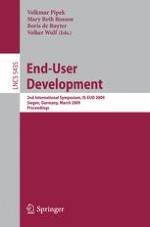Work practices and organizational processes vary widely and evolve constantly. The technological infrastructure has to follow, allowing or even supporting these changes. Traditional approaches to software engineering reach their limits whenever the full spectrum of user requirements cannot be anticipated or the frequency of changes makes software reengineering cycles too clumsy to address all the needs of a specific field of application. Moreover, the increasing importance of ‘infrastructural’ aspects, particularly the mutual dependencies between technologies, usages, and domain competencies, calls for a differentiation of roles beyond the classical user–designer dichotomy. End user development (EUD) addresses these issues by offering lightweight, use-time support which allows users to configure, adapt, and evolve their software by themselves. EUD is understood as a set of methods, techniques, and tools that allow users of software systems who are acting as non-professional software developers to 1 create, modify, or extend a software artifact. While programming activities by non-professional actors are an essential focus, EUD also investigates related activities such as collective understanding and sense-making of use problems and solutions, the interaction among end users with regard to the introduction and diffusion of new configurations, or delegation patterns that may also partly involve professional designers.
